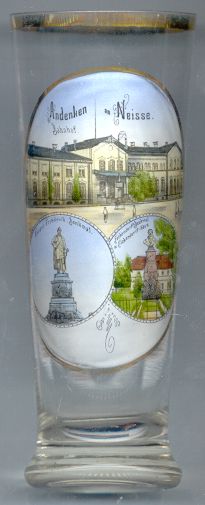

|
| POLSKA | POLAND |
| województwo: Opolskie | voivodship: Opole |
| powiat: Nysa | county: Nysa |
Nysa (German: Neiße) is situated at an elevation of 181 m on the river Nysa Kłodzka (Glatzer Neiße) in the southwest of the Opole voivodship of southern Poland. It has a population of about 52,000 (2004).
 Nysa is one of the oldest towns in Silesia. It was probably founded in the 10th century and afterwards became the capital of
a principality of its name, which around 1200 became part of the bishopric of Wrocław (Breslau).
The town received its first fortifications in 1350 so that Nysa could withstand the attacks of the Hussites in 1424. During
the Thirty Years' War (1618–1648) it was besieged three times. The first Silesian War (1740/1741, War of the Austrian
Succession) ended the Austrian sovereignty over Silesia and left Nysa in the hands of King Friedrich II of Prussia, who
laid the foundations of its modern fortifications. On 25 August 1769 Neiße was the site of a meeting between
Friedrich II of Prussia and Emperor Joseph II, co-regent in Austria. During the Napoleonic wars Nysa was taken by
the French in 1807. Neiße retained its mostly Catholic character within the predominantly Protestant province of Upper
Silesia in Prussia. Because of its many churches from the Gothic and Baroque periods the town was nicknamed "the Silesian
Rome".
Nysa is one of the oldest towns in Silesia. It was probably founded in the 10th century and afterwards became the capital of
a principality of its name, which around 1200 became part of the bishopric of Wrocław (Breslau).
The town received its first fortifications in 1350 so that Nysa could withstand the attacks of the Hussites in 1424. During
the Thirty Years' War (1618–1648) it was besieged three times. The first Silesian War (1740/1741, War of the Austrian
Succession) ended the Austrian sovereignty over Silesia and left Nysa in the hands of King Friedrich II of Prussia, who
laid the foundations of its modern fortifications. On 25 August 1769 Neiße was the site of a meeting between
Friedrich II of Prussia and Emperor Joseph II, co-regent in Austria. During the Napoleonic wars Nysa was taken by
the French in 1807. Neiße retained its mostly Catholic character within the predominantly Protestant province of Upper
Silesia in Prussia. Because of its many churches from the Gothic and Baroque periods the town was nicknamed "the Silesian
Rome".
The  Town Hall Tower [left]
was originally build in 1488–1499. The town hall was built in the 16th century. From the mid-18th century on, it
served as the garrison church and from 1885 to 1914 as Old Catholic church. The tower had a height of 95 metres and
was one of the most exquisite medieval towers in Silesia. Destroyed in 1945, the tower was rebuilt after the war in
simplified and modernised shape.
Town Hall Tower [left]
was originally build in 1488–1499. The town hall was built in the 16th century. From the mid-18th century on, it
served as the garrison church and from 1885 to 1914 as Old Catholic church. The tower had a height of 95 metres and
was one of the most exquisite medieval towers in Silesia. Destroyed in 1945, the tower was rebuilt after the war in
simplified and modernised shape.
[http://www.de.twierdzanysa.com/index.php?option=com_content&task=view&id=129&Itemid=33]

The bottom left picture on glass no. 1687 [near left] shows the
 monument
monument
The bottom right picture shows the
 monument
monument
The top picture shows the
 railway
railway
![[scale]](lineal.jpg)